Östersjötorskens viktiga roll
Torsken i Östersjön skiljer sig mycket från torsken i Nordsjön och Atlanten. Den har anpassats i både kroppen och beteendet till det bräckta vattnets låga salthalt. Torsken räknas som en av människans viktigaste matfiskar. Men ännu viktigare än som matfisk, är torskens roll i ekosystemet.
När mängden torsk förändras i Östersjön – förändras mängden av alla andra arter – ända ner till mikroskopiska djur och alger. När torsken minskar i antal och inte kan äta lika mycket mat som till exempel skarpsill, blir skarpsillarna fler. Det gör att skarpsillarna äter mer djurplankton. Då blir djurplanktonen färre, och de kan i sin tur inte äta lika mycket växtplankton som när näringskedjan är i balans. När det blir väldigt stora mängder växtplankton, blir det mer algblomning – en kraftig tillväxt av planktonalger. Det hotar i sin tur allt möjligt liv i havet, eftersom det både tar slut på syret i bottenvattnet, och riskerar att förgifta flera arter. Dessutom leder syrefria bottnar till att torskens ägg och yngel får svårare att överleva – och effekten förstärks.
När torsken minskar i antal på grund av överfiske och miljöförstöringar...
...ökar mängden skarpsill i havet, eftersom skarpsillen är viktig föda för torsken. Här ses skarpsillar inuti en torskmage.
Bild: Randel-Kreitsberg-CC-BY
Ökad mängd skarpsill leder i sin tur till färre djurplankton, som till exempel hoppkräftor, eftersom skarpsill äter djurplankton.
Bild: Frank-Fox-CC-BY-SA
Färre djurplankton leder till mer växtplankton, eftersom djurplankton äter växtplankton.
För mycket växtplankton leder till slut till algblomning - ett stort problem för Östersjön. Algblomningen leder i förlängningen till att det går sämre för torskens yngel - och på det sättet förstärker den negativa spiralen sig själv.
Bild: Envisat-satellite-CC-BY-SA
Överfisket i Östersjön och undantaget i Öresund
I Östersjön har torsken fiskats mycket hårt. Torsken blir könsmogen mellan 2 och 6 års ålder och kan leva upp till 25 år. När för unga torskar fiskas har de inte hunnit föröka sig – och populationen minskar. Det höga fisketrycket har lett till att östersjötorsken stressas att bli könsmogen tidigare än normalt, och många unga torskar är undernärda, angripna av parasiter och i dåligt skick.
Ett stort hot mot torsken är fiske med bottentrål – en slags påse som dras längs med bottnen. Förutom att fånga väldigt mycket fisk, förstör också trålen bottnarna. Den rycker upp bottenlevande djur och växter. I Öresund har fiske med trål varit förbjudet sedan 1930-talet. Det har lett till att torskarna i Öresund mår mycket bättre än i Östersjön.
En torsk kan bli könsmogen så sent som vid 6 års ålder, och kan leva upp till 25 år.
Bild: Joachim-S.-Müller-CC-BY-NC-SA
När torsken fiskas väldigt hårt hinner den aldrig växa till att bli stora individer som kan föröka sig mycket.
Bild: Jonn-Leffmann-CC-BY
Fiske med bottentrål är ett stort hot mot torsken.
Fiskekvoter och fiskestopp
Vissa torskbestånd har fiskats så hårt att de minskat till farligt låga nivåer. Arten klassas nu som sårbar enligt Rödlistan. Internationella Havsforskningsrådet ger råd om begränsat fiske. I EU har länderna enats om kvoter, för hur stor mängd torsk varje land får fiska upp. Man har också bestämt att torskar under en viss storlek inte får plockas upp. Detta för att man vill att torsken ska hinna föröka sig innan den fiskas. Även redskapen som används vid fisket begränsas. Men många menar att det inte räcker. Både Världsnaturfonden (WWF) och många forskare vill helt stoppa torskfisket i Östersjön.
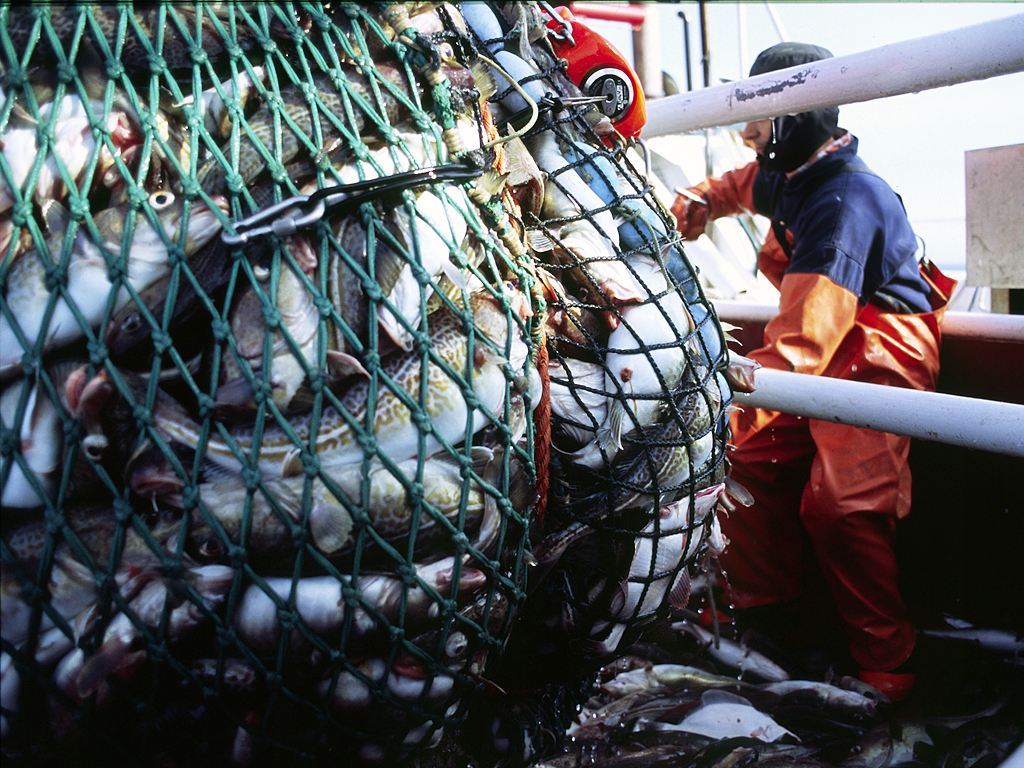
Den kanadensiska torskkollapsen
Längs Kanadas atlantkust ligger området Grand Banks. Där började torsk fiskas med trål redan i början av 1900-talet. I början ökade fångsterna kraftigt, och nådde sin topp under 1960-talet. I slutet av 1980-talet kollapsade torskbeståndet fullständigt, och 1991 förbjöds torskfisket i området. Då fanns bara omkring 1% av torsken kvar, i jämförelse med 1960.
Orsaken till kraschen var överfiske i kombination med låg tillväxt. Kraschen i kanadensiska Grand Banks liknar den som skett i Östersjön på många sätt, men eftersom Östersjön är ett innanhav med få andra stora rovfiskar, har överfisket om möjligt en ännu större påverkan här.

Torsk
Gadus morhua
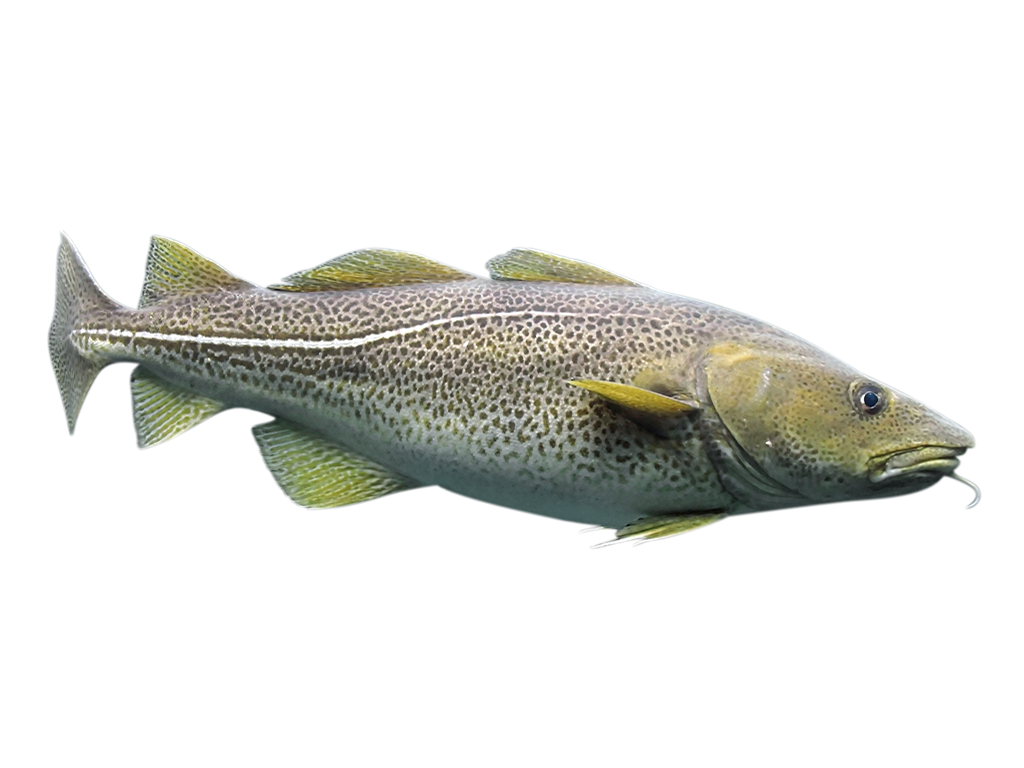
Skäggtöm som känselorgan
Ser du torskens skäggtöm som sticker ut på hakan? Den är ett kännetecken för torsken. Tömmen fungerar som ett känselorgan. Torskens färger varierar med miljön de lever i. Varje torsk har ett marmormönster som är unikt för just den individen, som ett fingeravtryck. Torsken blir könsmogen vid två till sex års ålder, och en hona kan lägga upp till 5 miljoner ägg under lekperioden. Den största torsken som någonsin fångats vägde 60 kg.
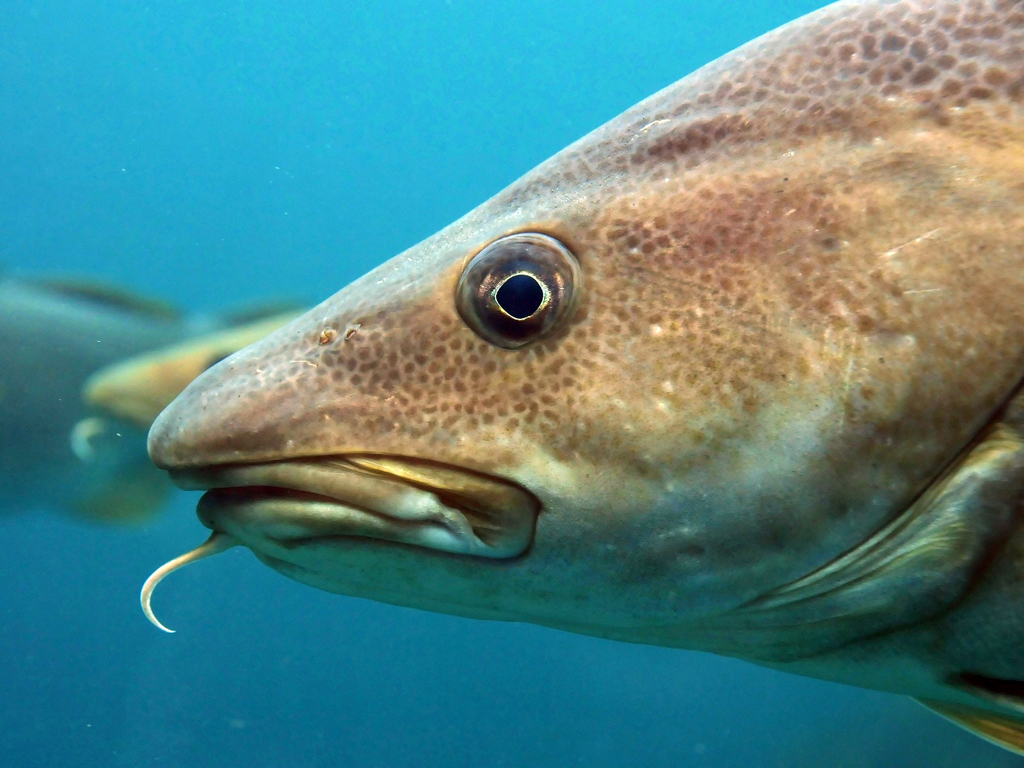
Bild: Joachim-S.-Müller-CC-BY-NC-SA
Utrotningshotat rovdjur
Torsken är en mycket viktig fiskart inom fiskeindustrin eftersom många tycker om att äta den. Torsken räknas som en predator, det vill säga en rovfisk. Eftersom torsken finns högt upp i näringskedjan, påverkas hela näringskedjan, när den fiskas för hårt.
När torsken minskar i antal och inte kan äta lika mycket mat som till exempel skarpsill, blir skarpsillarna fler. Det gör att skarpsillarna äter mer djurplankton. Då blir djurplanktonen färre och de kan i sin tur inte äta lika mycket växtplankton som när näringskedjan är i balans.
När det blir väldigt stora mängder växtplankton, blir det mer algblomning. Algblomning innebär en kraftig tillväxt av planktonalger. Algblomningen hotar i sin tur allt möjligt liv i havet eftersom det både tar slut på syret i vattnet, och riskerar att förgifta flera arter.
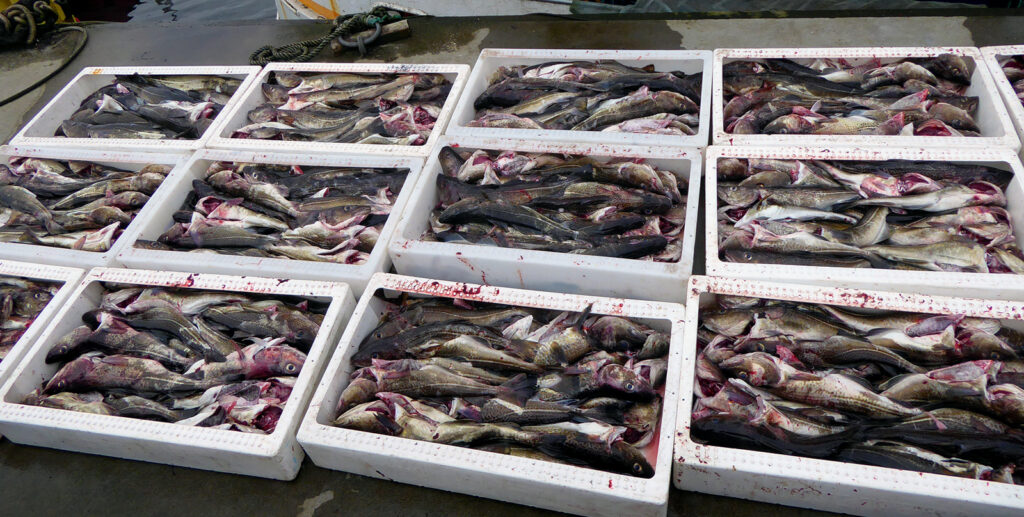
Bild: Jonn-Leffmann-CC-BY
Katastrofalt i Kattegatt
Antalet torskar har minskat på många platser. I södra- och mellersta Östersjön till exempel med 75 %. I Kattegatt menar många att läget är katastrofalt. Det anses vara mindre torsk där än någonsin innan. Torsken är mer hotad i Norden än i övriga världen.
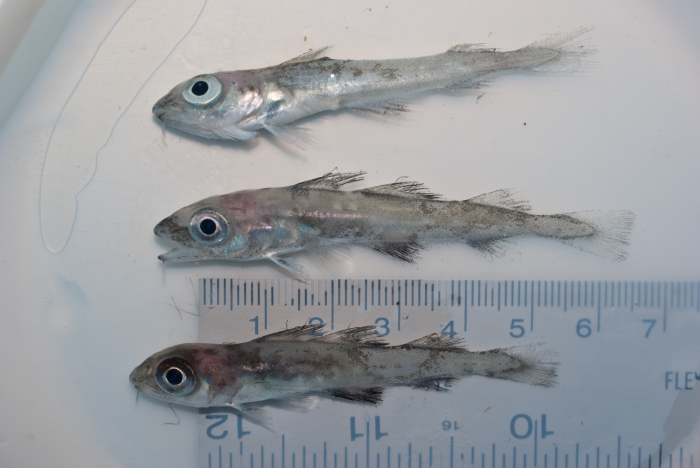
Bild: Nozères-Claude-CC-BY-NC-SA
Vad kan jag göra för torsken?
Viktigast är att påverka politiska beslut så att de blir bättre för haven. Du kan delta i protester eller demonstrationer, engagera dig i ett parti eller gå med i en organisation som försöker ändra på politikernas inställning till havsfrågor, som till exempel Svenska Naturskyddsföreningen eller Världsnaturfonden WWF.
Sluta ät fisk, eller köp inte fisk eller skaldjur som är utrotningshotade. Välj fisk som är MSC-märkt. MSC är en internationell märkning för hållbart fiske.
Välj KRAV -märkt när du köper odlad fisk. Fråga efter fisk som inte är utrotningshotad på restaurangen eller i butiken.
Utbredningsområde i Sverige
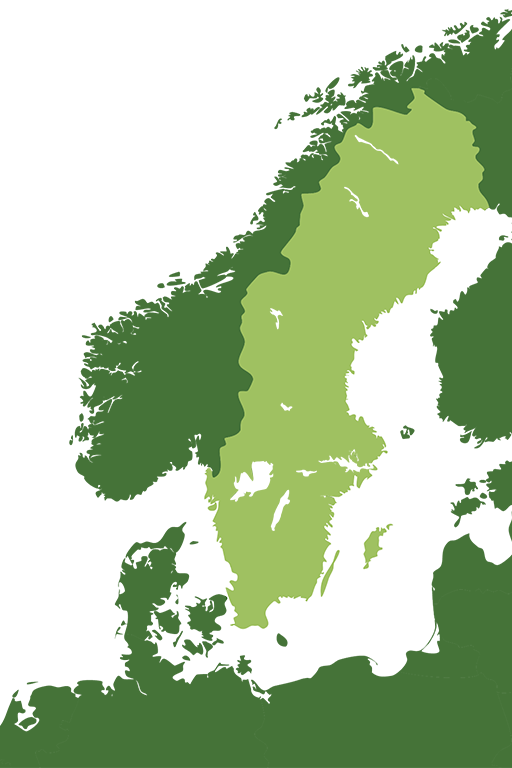
Finns i alla svenska hav.
Vit markering = Utbredningsområde
Hotstatus enligt Rödlistan

Reglerad inom handel
CITES: Ej listad.

Gråsej
Pollachius virens

Flyttfisk med underbett
Gråsej är en storväxt och muskulös torskfisk som lever i stim. Den är släkt med torsk, vitling, kolja och andra torskfiskar som är vanliga i matbutiken och på restaurang. Till skillnad från de flesta andra torskfiskar saknar gråsejen en skäggtöm, men den har ett karaktäristiskt underbett som blir tydligare ju äldre den blir.
Gråsejen är vad man skulle kunna kalla en flyttfisk! Ett nykläckt gråsejsyngel förs med havsströmmarna till klippiga kustområden, och håller till på grunt vatten. Den unga gråsejen äter djurplankton som den silar fram ur vatten med hjälp av sina gälräfständer – ett slags kammar som sitter längs med fiskens gälbågar. När gråsejen växer sig större flyttar den ut mot öppet hav, där den lever i stim.
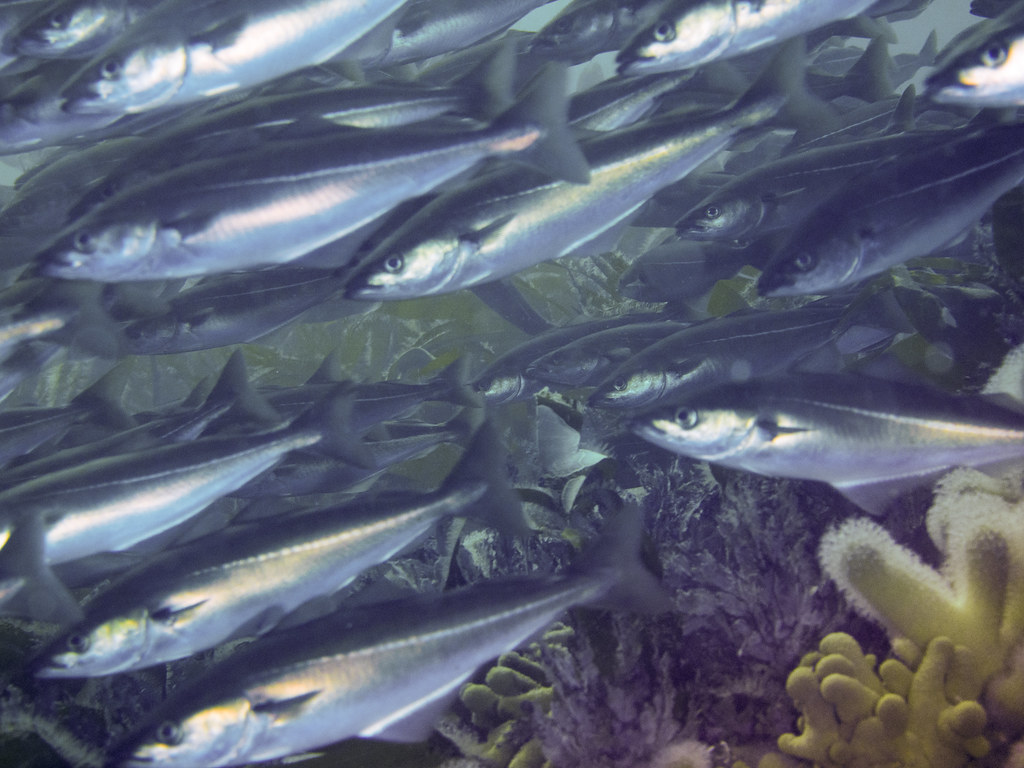
Bild: SNH-Images-CC-BY-NC-SA
Lägger åtta miljoner ägg
Gråsejar jagar tillsammans genom att omringa stim av småfisk och tränga upp dem mot vattenytan. När detta sker ser vattnet nästan ut som om det kokar, då hela ytan bubblar. Födan består främst av sill och skarpsill. Gråsejens lekperiod sträcker sig från januari till maj. En stor hona kan lägga upp till åtta miljoner ägg. De första fem åren växer Gråsejen 10 centimeter om året.

Bild: Smithsonian-Environmental-Research-Center-CC-BY
Utbredningsområde i Sverige
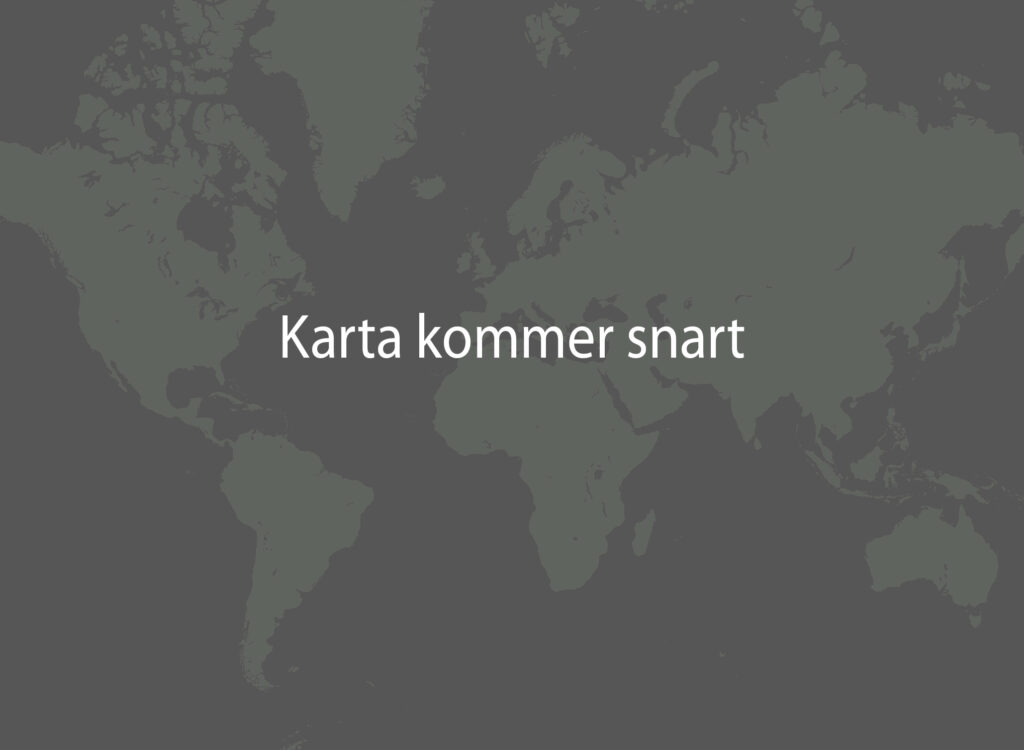
Skagerrak, Kattegatt och sporadiskt i Öresund och södra Östersjön.
Hotstatus enligt Rödlistan

Reglerad inom handel
CITES: Ej listad.

Piggvar
Scophthalmus maximus
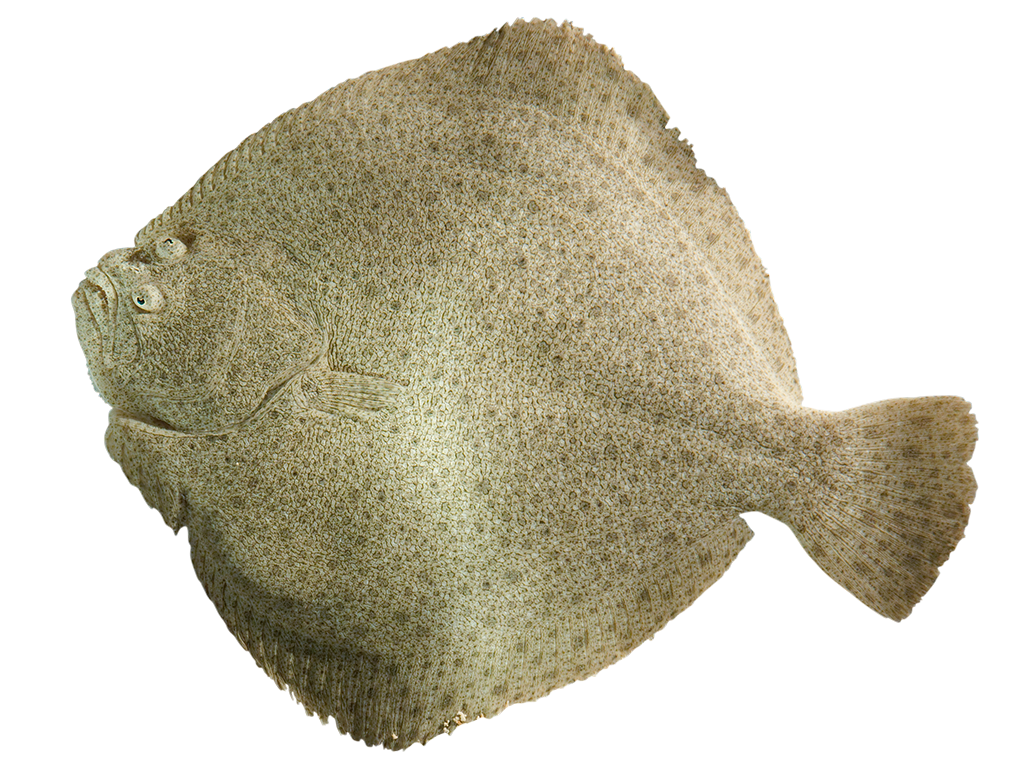
Välkamouflerad mot sanden
Piggvaren kan vara svår att få syn på. Titta noga efter mörka fläckar på ovansidan av kroppen som är sandfärgad. Det är en plattfisk som kamouflerar sig bra på sandiga bottnar. Som alla plattfiskar har piggvaren ögonen på varsin sida av kroppen när de kläcks som yngel. Efter en liten tid ”vandrar” det ena ögat över till andra sidan och piggvaren lever resten av sitt liv som plattfisk.

Bild: Yvan-CC-BY-NC-SA
Kallas vattenfasan
Många tycker om att äta piggvar. I det gamla romarriket var den lika omtyckt som fågeln fasan. Därför kallades piggvaren för vattenfasan. Ett namn som fransmännen använder sig av än idag.
Piggvarens lekperiod är mellan april och augusti. Honan kan precis som torskhonan lägga upp till 15 miljoner ägg.

Bild: Johanna-Rylander-Malmö-Museer
Utbredningsområde i Sverige
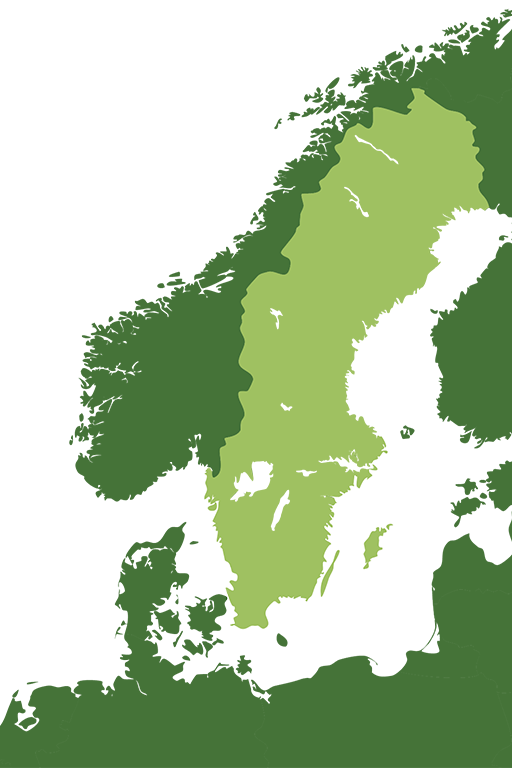
Längs hela västkusten till Ålands hav i Östersjön.
Vit markering = Utbredningsområde.
Hotstatus enligt Rödlistan

Reglerad inom handel
CITES: Ej listad.

Slätvar
Scophthalmus rhombus

Glupskt rovdjur!
Slätvaren är mycket lik sin närmsta släkting piggvar, men skillnaden mellan de två hörs i namnet! Slätvaren är slät på ovansidan medan piggvaren har benknölar – piggar – på ovansidan av kroppen. Med sin stora mun är slätvaren en mycket glupsk rovfisk. Som vuxen äter den helst fisk, tobis, smörbultar och sill till exempel.
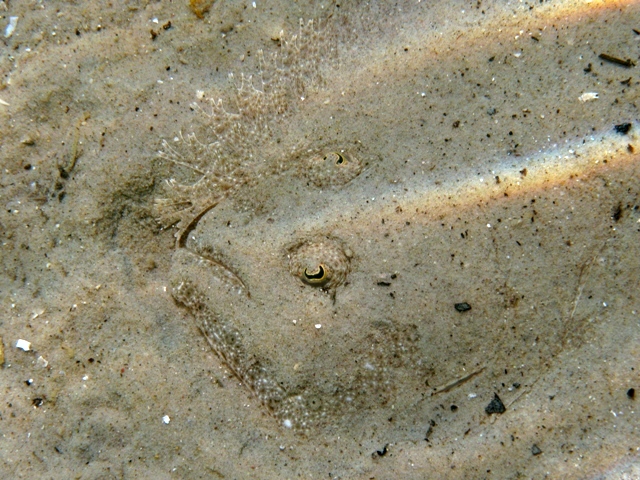
Bild: Roberto-Pillon-CC-BY
Ögat byter sida
När ett slätvarsyngel kläcks ser det ut som en “vanlig” fisk – alltså att ögonen sitter på var sin sida om kroppen. När de växt till ca 3,5 cm i längd börjar en stor förvandling. Det högra ögat “vandrar” över till fiskens vänstra sida och kroppen vrids så att fiskens högersida nu blir dess undersida.
Efter detta lever slätvaren ett liv främst på bottnen, väl kamouflerad av sin sandliknande ovansida. Alla fiskar i gruppen plattfiskar går igenom den här förvandlingen!

Bild: Roberto-Pillon-CC-BY
Äggen och ynglen klarar sig själva
Under våren och sommaren är det slätvarens parningsperiod. En hona kan då släppa ifrån sig ca 850 000 ägg, som får sväva fritt i vattnet. Äggen tas inte om hand av föräldrarna utan lämnas där och då åt sitt öde. Ett nykläckt slätvarsyngel är bara 4 mm långt och lever i den fria vattenmassan tills det är dags för förvandling till plattfisk.
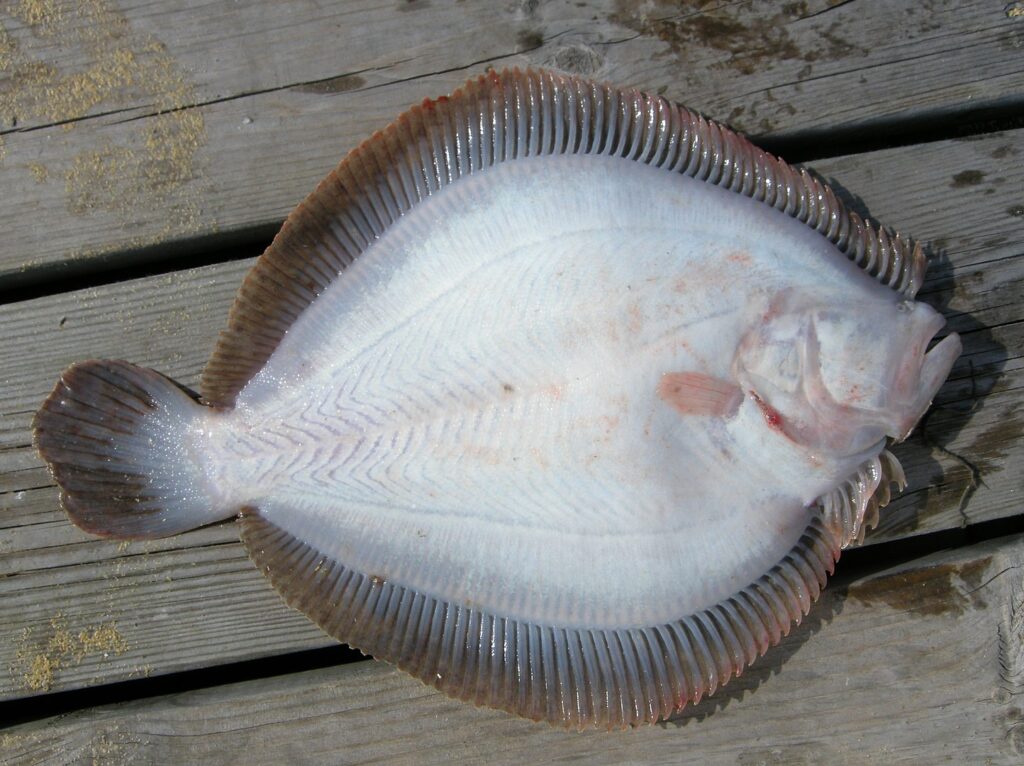
Bild: Arnstein-Rønning-CC-BY-SA
Utbredningsområde i Sverige
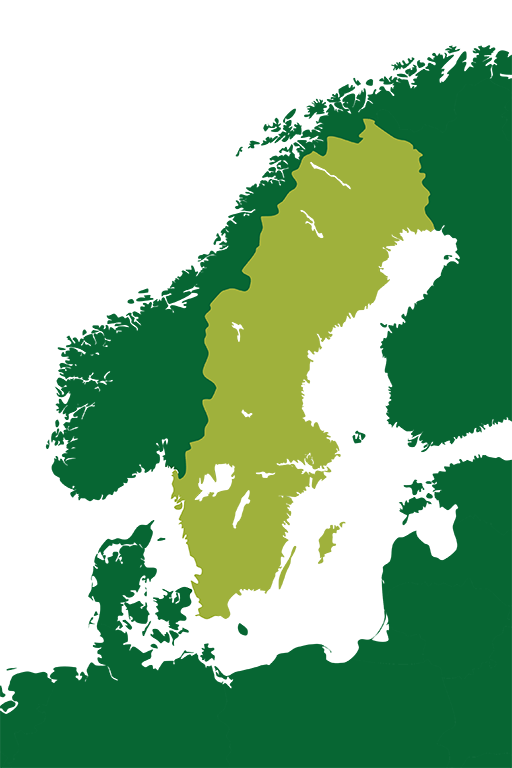
Västkusten, ibland ned till Öresund.
Vit markering = Utbredningsområde
Hotstatus enligt Rödlistan

Reglerad inom handel
CITES: Ej listad.

Rödspätta
Pleuronectes platessa

Ögat byter sida
Har du trampat på eller sett små plattfiskar på botten vid stranden när du badat under sommaren? Det är ofta unga rödspättor som snabbt simmar iväg. De äldre trivs bättre på lite djupare vatten.
När en rödspätta kläcks ur sitt ägg ser den ut som en pytteliten version av en “vanlig” fisk – med ögonen på varsin sida om kroppen. När rödspättan växt lite sker en förvandling, där det ena ögat “vandrar” över till den andra sidan. Efter det lever rödspättan på bottnen. Du känner igen rödspättan på de typiska röda prickarna.
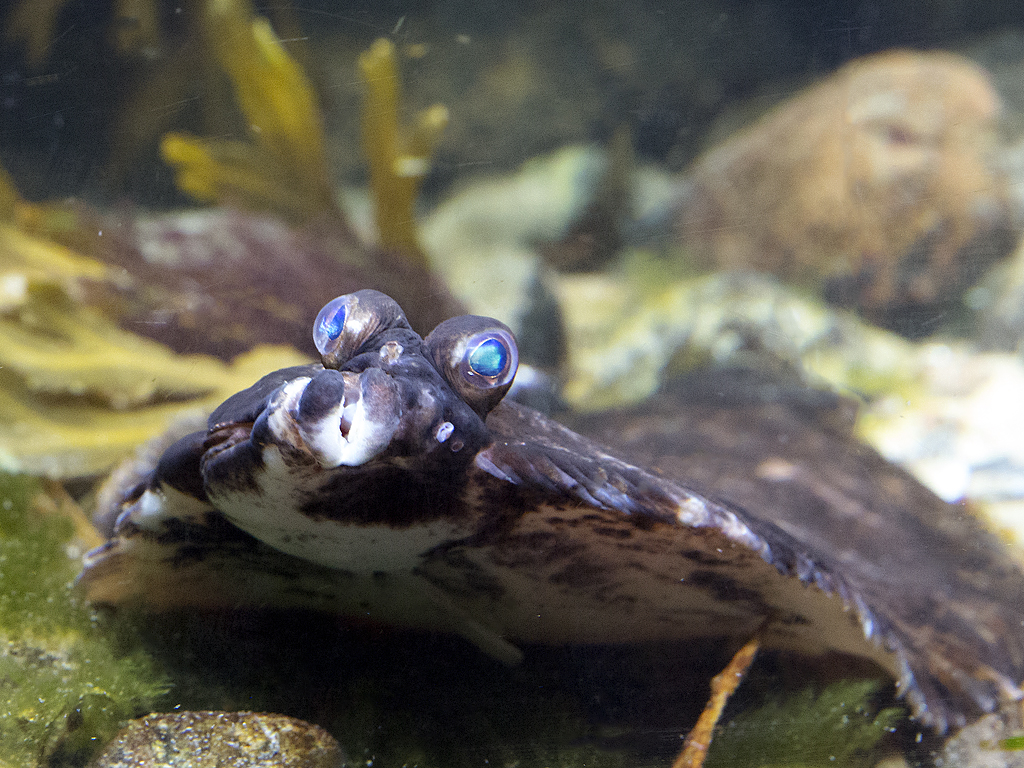
Bild: Johanna-Rylander-Malmö-Museer
Har överfiskats
Rödspättan höll på att försvinna för att haven var förorenade och övergödda för 30-40 år sedan. Men haven mår bättre och rödspättorna i Nordsjön är på väg att långsamt bli fler.
Många fiskare fångar rödspätta eftersom många tycker om att äta den. Men den har överfiskats. Därför får den bara fiskas under vissa perioder på året. Har du ätit fisken?
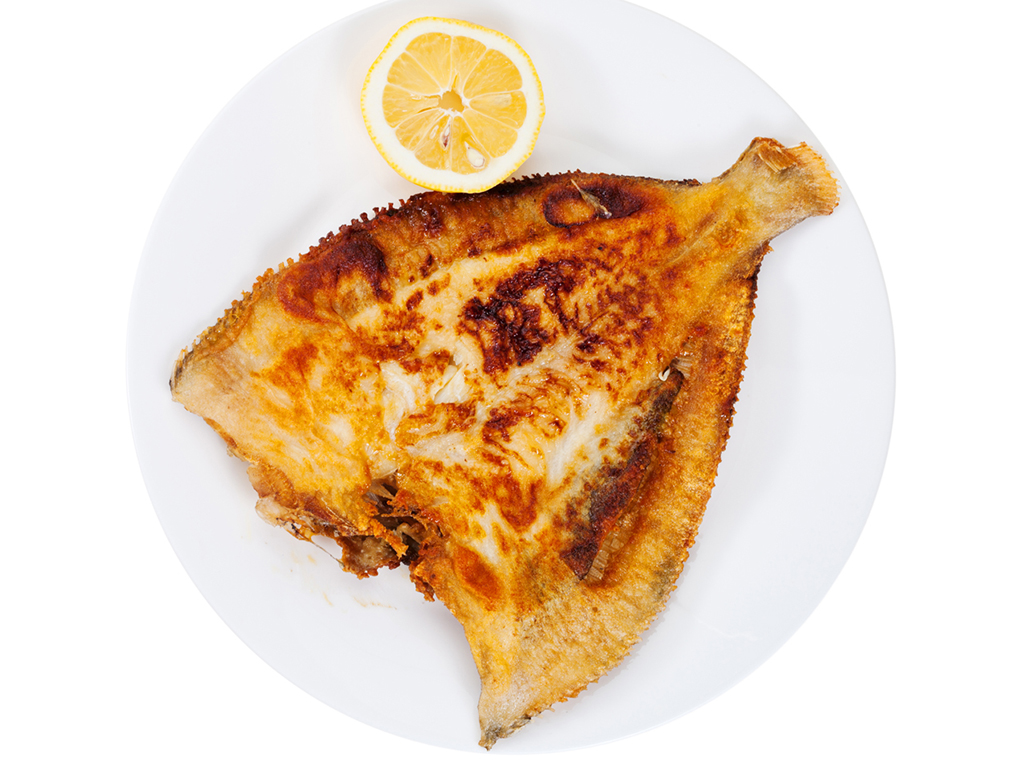
Utbredningsområde i Sverige

Bohuslän till Stockholms skärgård. Ovanlig längre norrut i Östersjön.
Vit markering = Utbredningsområde
Hotstatus enligt Rödlistan

Reglerad inom handel
CITES: Ej listad.

Skrubbskädda
Platichthys flesus
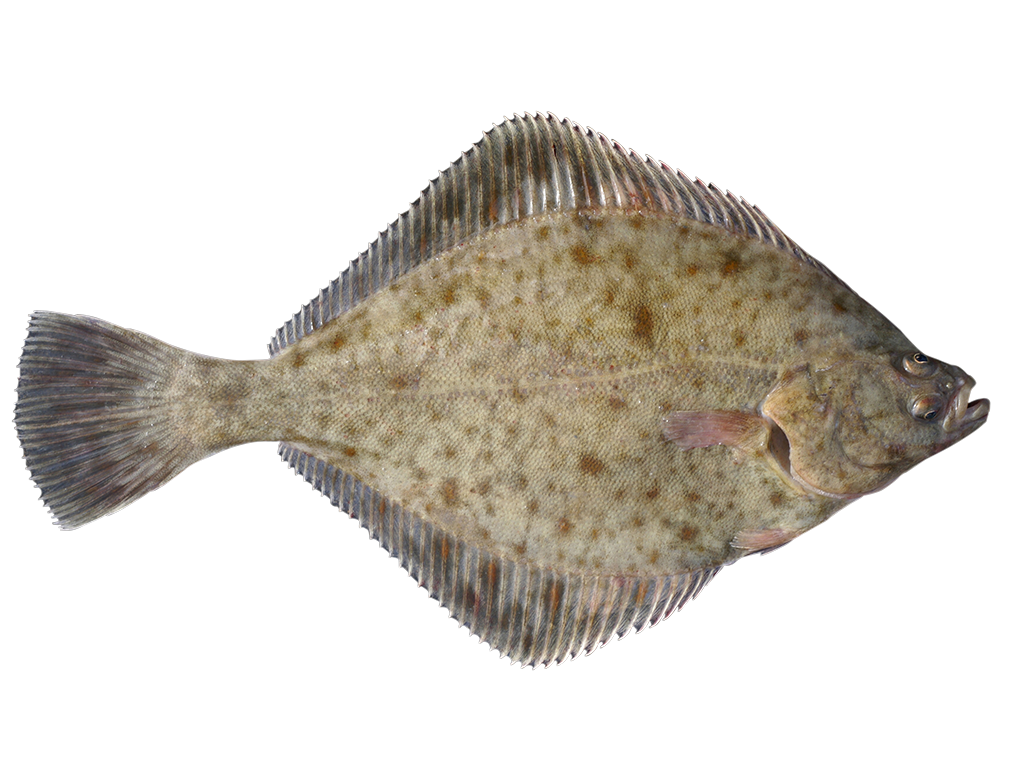
Vassa knölar på ryggen
Ser du att skrubbskäddan liknar rödspättan? Den kan till och med ha röda fläckar på ryggsidan precis som rödspättan. I mitten på ryggen har den en massa skrovliga, vassa knölar. De fortsätter längs kroppen ner till analfenan. Därför kallas skrubbskäddan även för skrubba. Det beror på den har en ”skrubbiga” ryggen.
Skrubbskäddan fiskas i Nordsjön och Östersjön. Många gillar att äta den varmrökt. Som matfisk kallas den ofta för flundra. Skrubbskäddan är Ölands landskapsfisk.
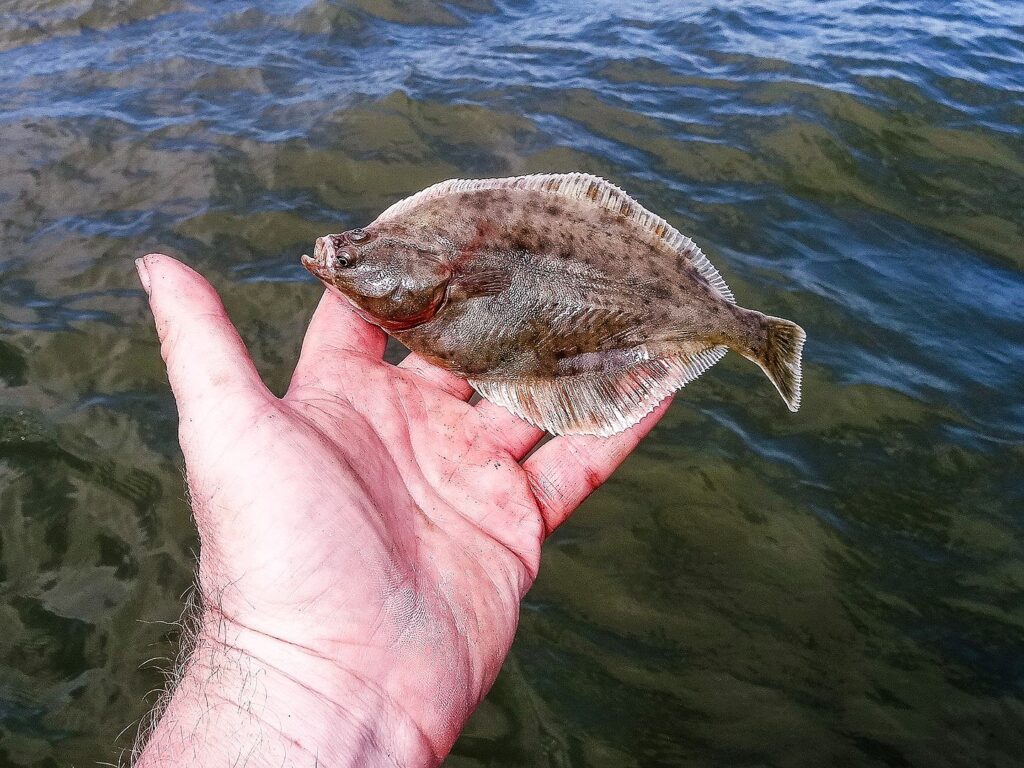
Bild: Peter-van-der-Sluijs-CC-BY-SA
Ögat byter sida
När en skrubbskädda kläcks ur sitt ägg ser den ut som en pytteliten version av en “vanlig” fisk – med ögonen på varsin sida om kroppen. När skrubbskäddan växt lite sker en förvandling, där det ena ögat “vandrar” över till den andra sidan. Efter det lever skrubbskäddan på bottnen.
När skrubbskäddan är ung kan den leva i sötvatten. De vandrar ibland upp i floder och bäckar. När det är dags att para sig simmar fisken tillbaka till havet och saltvatten. Där stannar den resten av livet.
Utbredningsområde i Sverige

Bohuslän till Stockholms skärgård, ibland Bottniska havet.
Vit markering = Utbredningsområde
Hotstatus enligt Rödlistan

Reglerad inom handel
CITES: Ej listad.

Blågylta
Labrus mixtus
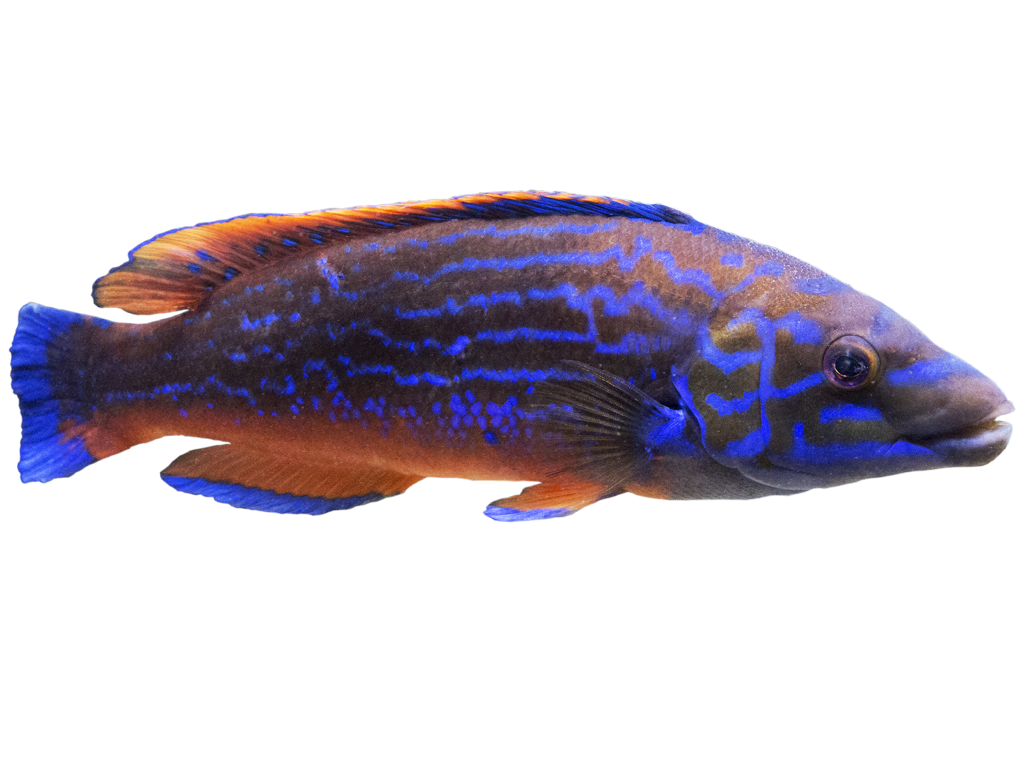
Kallas blåstråle och rödnäbba
Nästan alla blågyltor föds som honor, de är då ljust rosa, bruna eller beiga i färgen, med svarta fläckar längst bak på ryggen. Honorna av blågylta kallas för rödnäbba. De stora hanarna blir färgsprakande vackra i blått och orange, och kan verkligen lysa starkt med sina färger. De kallas för blåstråle. Det kan vara svårt att föreställa sig att så vackra fiskar hör hemma någon annanstans än i tropikerna, men blågyltan simmar faktiskt även i svenska vatten!
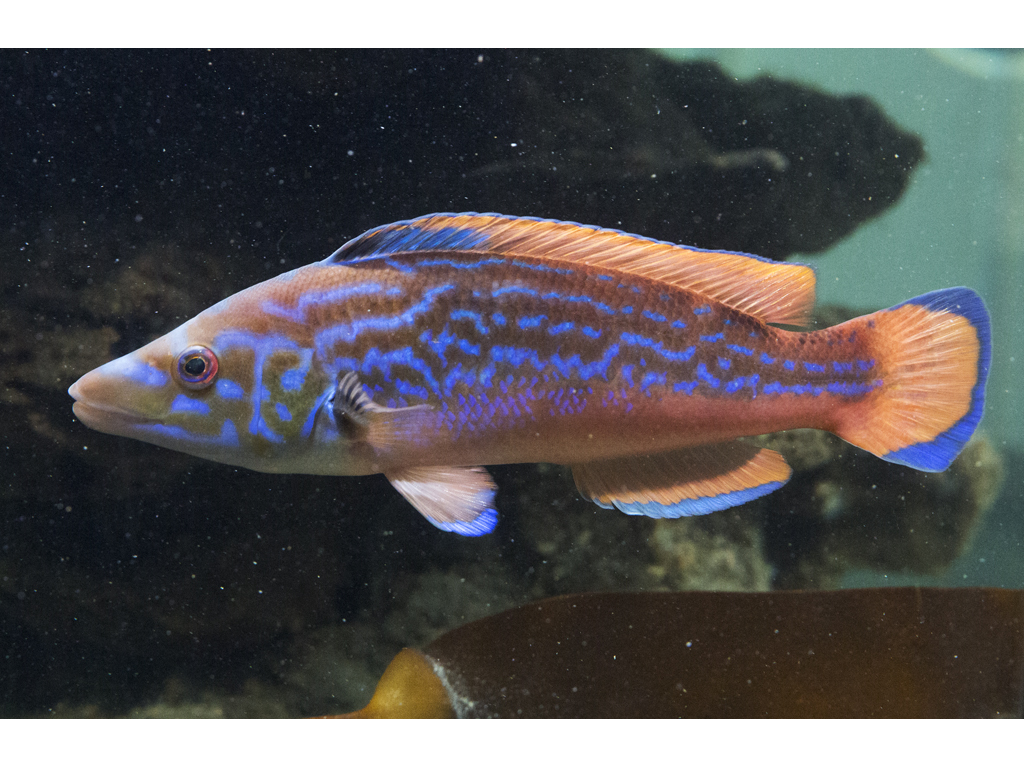
Bild: Johanna-Rylander-Malmö-Museer
En hane med upp till 40 honor
Blågyltan är en bottenlevande fisk som oftast håller till på ned till 80 meters djup, men ute i Atlanten finns grupper av blågyltor som går ner till mer än 200 meters djup, åtminstone vintertid. De håller sig gärna i klippiga kustområden. De stora hanarna – blåstrålarna – har stora revir med upp till 40 honor i varje. Under parningstiden bygger hanen en grop i sandbottnen för honorna att lägga sina ägg i. När han befruktat alla äggen vaktar han dem noga tills de kläcks efter ungefär 10 dagar – sedan lever ynglen sin första tid i den fria vattenmassan, innan de letar sig ned mot bottnen.

Bild: Diego-Delso-CC-BY-SA
Två olika sorters arter visade sig vara två olika sorters hanar
Länge trodde man att blågyltan egentligen var två olika arter. Det finns nämligen två olika sorters hanar hos blågyltan. Blåstrålarna är stora och blå hanar, som fötts som honor men bytt kön! De kallas för ”terminala” hanar. Ett fåtal blågyltor föds dock som hanar – så kallade ”primära” hanar. De primära hanarna ser ut som honor i färg och form, och därför trodde man inte förr att de blå hanarna tillhörde samma art som rödnäbborna och de primära hanarna.
Så länge det finns en blåstråle i ett revir, kommer inga rödnäbbor i det reviret att byta kön till hane. Om blåstrålen däremot försvinner av någon anledning, kommer den största och mest dominanta honan i reviret att påbörja sin omvandling till ny hane. Det är först vid 7-13 års ålder som det är möjligt för en rödnäbba att bli en blåstråle. De primära hanarna, alltså de som föds som hanar men ser ut som honor, kommer aldrig att bli blåstrålar. Däremot kan de leva som ”infiltratörer” i en grupp med honor, och passa på att befrukta ägg när revirets blåstråle har fullt upp med parningslek. På så vis kan både primära och terminala hanar av blågyltan få föra sina gener vidare.
Utbredningsområde i Sverige
Västkusten och ibland ned till Öresund.
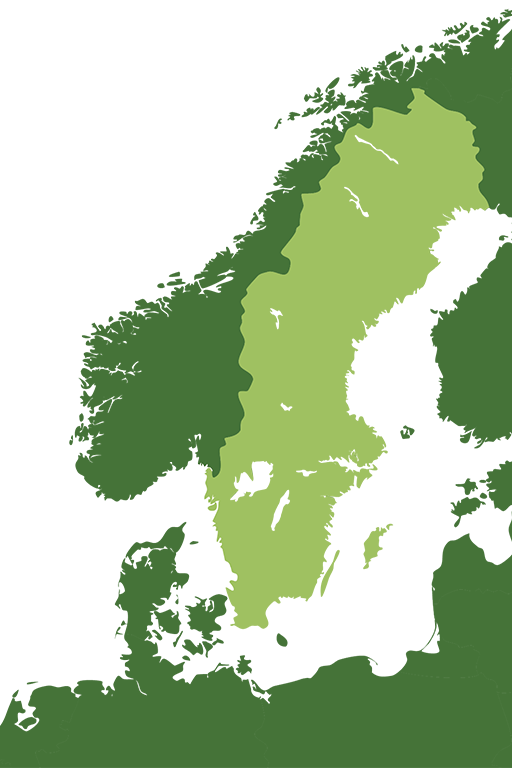
Hotstatus enligt Rödlistan

Reglerad inom handel
CITES: Ej listad.

Vad är Rödlistan?
Rödlistning är ett sätt att bedöma om olika djur- och växtarter är utrotningshotade utifrån kriterier som hur många djur eller växter som finns av arten och hur utbredda de är. En nationell rödlistning bedömer artens risk att dö ut inom ett lands gränser. Den internationella rödlistningen bedömer artens risk att dö ut över hela jorden.
Läs mer

Om rödlistning i Sverige: Artdatabanken, www.artdatabanken.se
Om rödlistning i världen: International Union for Conservation of Nature, IUCN, www.iucn.org

Vad är CITES?
För att bekämpa olaglig handel med djur och växter finns en internationell överenskommelse om handel, som heter CITES. CITES innebär att utrotningshotade djur och växter inte får köpas eller säljas mellan olika länder utan tillstånd.
CITES klassar olika arter i olika kategorier (som kallas Appendix I, II och III) beroende på hur hotad arten är. Ju större hotet från handeln är desto högre skydd. Inom EU finns ytterligare skydd för arter i CITES. EU:s egen klassning har fyra steg: A-D.

Bild: Steve-Hillebrand
Förbjudet att handla med viltfångade arter
Högst skydd mot handel har de arter som är inom kategori A och B. Här gäller oftast att handel mellan EU och övriga världen är förbjuden utan tillstånd. Arter som är CITES A eller B-klassade får inte heller köpas eller säljas inom EU om det inte kan bevisas att de har lagligt ursprung och inte fångats i det vilda.
Att använda växter eller djur för att tillverka souvenirer och annat är också förbjudet. Den som bryter mot reglerna kan dömas till böter eller fängelse.
Kontrollera spridning av arter

Arter som är CITES C-klassade är utrotningshotade i ett visst land men inte nödvändigtvis i hela världen. CITES D-klassning betyder att en art importeras i så stort antal att de behöver regleras för att inte riskera att sprida sig okontrollerat där de inte hör hemma.

The important role of the Baltic cod
The cod in the Baltic Sea is very different from the cod in the North Sea and the Atlantic. It has adapted both its body and its behavior to the low amount of salt in the brackish water. Cod is considered one of the most important fish for human consumption. But even more important than its status as a food fish, is the role of cod in the ecosystem.
When the amount of cod changes in the Baltic Sea, the amount of all the other species changes, right down to microscopic animals and algae. When the cod population falls and they are not eating as much of their food, such as sprats for example, the sprats grow in number. The sprats then eat more zooplankton (tiny animals). The zooplankton is then not eating as much phytoplankton (microscopic algae) as when the food chain is in balance. And very large amounts of phytoplankton mean more algal blooms – a major growth of planktonic algae. This, in turn, threatens all kinds of marine life, as it removes the oxygen in the bottom waters and risks poisoning several species. In addition, oxygen-free bottoms make it harder for cod eggs and fry to survive – worsening the effect.
When the cod decreases in number due to overfishing and environmental damage...
...the amount of sprat in the sea increases, as sprat is an important food for cod. Here, sprat are seen inside a cod belly.
Photo: Randel-Kreitsberg-CC-BY
Increased amount of sprat in turn leads to fewer zooplankton, such as copepods, because sprat eats zooplankton.
Photo: Frank-Fox-CC-BY-SA
Less zooplankton leads to more phytoplankton, because zooplankton eat phytoplankton.
Too much phytoplankton eventually leads to algal blooms - a major problem for the Baltic Sea. In the long run, the algal bloom leads to worse conditions for the cod's fry - and in this way the negative spiral strengthens itself.
Photo: Envisat-satellite-CC-BY-SA
Overfishing in the Baltic Sea, and the exception in Öresund
In the Baltic Sea, cod has been fished very hard. Cod reach sexual maturity at between 2 and 6 years of age and can live up to 25 years. When fishermen catch cod that are too young, the fish have not had time to reproduce – and the population declines. The high fishing pressure has put stress on Baltic cod to reach sexual maturity earlier than normal, and many young cod are undernourished, infested with parasites and in poor health.
A major threat to cod is bottom trawling, where a kind of net bag is pulled along the bottom of the sea. In addition to catching a lot of fish, the trawling also damages the seabed, churning up bottom-dwelling animals and plants. Trawling has been banned in the Öresund strait since the 1930s. As a result, cod are doing much better in Öresund than in the Baltic.
A cod can become sexually mature as late as 6 years of age, and can live up to 25 years.
Photo: Joachim-S.-Müller-CC-BY-NC-SA
When the cod is pressured due to overfishing, it never has time to grow into large individuals that can reproduce a lot.
Photo: Jonn-Leffmann-CC-BY
Bottom trawl fishing is a major threat to cod.
Fishing quotas and bans
Some cod stocks have been fished so heavily that they have declined to dangerously low levels. The species is now classified as vulnerable on the Red List. The International Council for the Exploration of the Sea advises on restricted fishing. The EU countries have agreed on quotas for how much cod each country can catch. It has also been decided that cod below a certain size must not be caught. This is because they want the cod to have time to reproduce before it is fished. The gear used in fishing is also restricted. But many say that is not enough. The World Wild Fund for Nature (WWF) and many scientists want to stop cod fishing in the Baltic Sea altogether.

The Canadian cod collapse
Along Canada’s Atlantic coast lies the Grand Banks area, where bottom trawling for cod began back in the early 1900s. Initially, catch sizes rocketed up, peaking in the 1960s. But in the late 1980s the cod stock collapsed completely, and in 1991 cod fishing was banned in the area. At that time, only about 1% of the cod population remained, compared to 1960.
The cause of the crash was overfishing combined with low growth. The collapse in the Canadian Grand Banks is similar to what is happening in the Baltic Sea in many ways, but as the Baltic is an inland sea with few other large predatory fish, the impact of overfishing is possibly even greater here.

Atlantic Cod
Gadus morhua

Barbel as sensory organ
Can you see the cod’s chin barbel? It is characteristic of the cod and functions as a sensory organ. The cod’s colour varies with its environment. Each cod has a marble pattern that is unique to the individual, like a fingerprint. The cod becomes sexually mature between two and six years of age, and a female can lay up to 5 million eggs during the spawning period. The largest cod ever caught weighed 60 kilograms.

Photo: Joachim-S.-Müller-CC-BY-NC-SA
Endangered predator
The Atlantic cod is a very important species to the fishing industry because many people enjoy it as a food fish. The cod is a predator, and because it is found at the top of the food chain the entire food chain is affected when the cod is fished too extensively.
When the cods decrease in number, they cannot eat as many bristling, herring and other smaller fishes, which means more of these are left alive to eat zooplankton. That means less zooplankton, and they can in turn not eat as much phytoplankton as when the food chain is in equilibrium.
And large quantities of phytoplankton mean algae blooms, i.e. a massive growth of planktonic algae. Algae blooms in turn threaten all sorts of marine life because they cause oxygen depletion in the water and can poison several species.

Photo: Jonn-Leffmann-CC-BY
A catastrophe in the Kattegatt
The number of cods has decreased in many places. For example, in the south and mid Baltic, it has decreased by 75 %. And in the Kattegat, many people say that the situation is catastrophic as estimations show that there are fewer cod there than ever before. The cod is more threatened in Scandinavia than in the rest of the world.

Photo: Nozères-Claude-CC-BY-NC-SA
What can I do to help the Atlantic cod?
The most important thing anyone can do is to influence political decisions to improve the situation in the world’s oceans. You can participate in protests or demonstrations, become politically involved, or join an organisation that is trying to change the politicians’ view on marine matters – such as the Swedish Society for Nature Conservation or the World Wildlife Foundation (WWF).
You can stop eating and buying fish and shellfish that are endangered or threatened. Choose fish with the MSC label, which is an international label for sustainable fishing. Choose fish with the KRAV label when you buy farmed fish.
Ask for fish that is not endangered or threatened when you are at a restaurant or in a grocery store.
Distribution in Sweden

Skagerak, Kattegatt and the Baltic Sea.
White marking = Distribution
Threat based on the Red List

Trade regulations
CITES: Not listed.

Saithe
Pollachius virens

Migrating fish with underbite
The saithe is a large, muscular codfish that lives in shoals. It is related to cod, whiting, haddock and other codfish, that are common in supermarkets and restaurants. Unlike most other codfish, the saithe does not have a whisker-like barbel, but it does have a characteristic underbite that becomes more pronounced as it ages.
The saithe is what you might call a migratory fish! A newly hatched saithe is carried by ocean currents to rocky coastal areas, and stays in shallow water. The juvenile saithe feeds on zooplankton, which it sifts out of the water using its gill rakers – a kind of comb that sits along the fish’s gill arches. As the saithe grows larger, it moves out to the open sea, where it lives in shoals.

Photo: SNH-Images-CC-BY-NC-SA
Lay eight million eggs
Saithe hunt together by surrounding schools of small fish and pushing them towards the surface. When this happens, the water almost looks like it is boiling, as the entire surface bubbles. The food consists mainly of herring and sprat. The saithe spawning season runs from January to May, and a large female can lay up to eight million eggs. In the first five years, the saithe grows 10 centimetres a year.

Photo: Smithsonian-Environmental-Research-Center-CC-BY
Distribution in Sweden

Skagerrak, Kattegat and sporadically in Öresund and the southern Baltic.
Threat based on the Red List

Trade regulations
CITES: Not listed.

Turbot
Scophthalmus maximus

Well-camouflaged against the sand
Turbot can be hard to see. Look carefully for dark spots on the top side of its body, which is a sandy colour. Turbot is a flatfish which camouflages itself well against a sandy seabed.
Like all flatfish, when a turbot fry hatches it looks like a “normal” fish, with one eye on each side of its head. But after a while, a transformation occurs. One of the eyes “migrates” across to the other side of the body, and the turbot lives the rest of its life like a flatfish.

Photo: Yvan-CC-BY-NC-SA
Called ”water pheasant”
Many people like eating turbot. In the Roman Empire, turbot was as popular to eat as a bird called the pheasant. That is why the turbot was called the “water pheasant”. In France people still use that name today.
The turbot spawns from April to August. Like female cod, female turbot can lay up to 15 million eggs each.

Photo: Johanna-Rylander-Malmö-Museer
Distribution in Sweden

Along the entire west coast and in the Baltic up to the Sea of Åland.
White marking = Distribution
Threat based on the Red List

Trade regulations
CITES: Not listed.

Brill
Scophthalmus rhombus

Voracious!
The brill looks a lot like its closest relative, the turbot. The easiest way to tell them apart is to look at their top sides: the brill is smooth but the turbot has bony protrusions on the skin. With its large mouth, the brill is a voracious predator. As an adult, it mostly eats fish such as sand lance, gobies, and herring.

Photo: Roberto-Pillon-CC-BY
The eye moves to the other side
When a brill fry hatches it looks like a “normal” fish – with one eye on each side of its head. But when it has grown to about 3.5 cm in length, a transformation occurs. The right eye “migrates” across to the left side, and the body turns so that its right side becomes its underside.
After the transformation, the brill lives on the sea floor. The side of the brill facing away from the sea floor looks like sand, providing camouflage. All flatfish experience this kind of transformation.

Photo: Roberto-Pillon-CC-BY
The eggs and fry are left on their own
The spring and summer make up the brill’s spawning period. A female can release around 850,000 eggs, which are left floating in the water. The parents do not look after the eggs but leave them on their own. A newly hatched brill fry is only 4 mm long and lives in open water until it transforms into a flatfish and moves to the sea floor.

Photo: Arnstein-Rønning-CC-BY-SA
Distribution in Sweden

The West Coast, sometimes down to Öresund.
White marking = Distribution
Threat based on the Red List

Trade regulations
CITES: Not listed.

European plaice
Pleuronectes platessa

The eye moves to the other side
Have you ever stepped on or seen small flatfish on the bottom when you go swimming in the sea in the summer? Those are often young plaice that quickly swim away. Older specimens live in deeper water.
When a plaice hatches from its egg, it looks like a miniature version of a “normal fish” – with one eye on each side of its head. When the plaice has grown somewhat a transformation occurs and one eye “migrates” across to the other side. After that the plaice lives on the bottom. The European plaice is characterised by its red spots.

Photo: Johanna-Rylander-Malmö-Museer
Regulated fishing
Plaice are disappearing because the oceans were polluted and overfertilised 30 to 40 years ago. But the oceans are now in better condition and plaice in the North Sea are slowly increasing in number.
Many fishermen catch plaice because many people like to eat it. That is why it can only be fished during certain periods of the year.

Distribution in Sweden

Bohuslän to the Stockholm archipelago. Rare farther north in the Baltic Sea.
White marking = Distribution
Threat based on the Red List

Trade regulations
CITES: Not listed.

European Flounder
Platichthys flesus

Sharp lumps on its back
Can you see that the flounder looks like a plaice? It can even have red spots on its back just like a plaice. In the middle of its back it has lots of rough, sharp lumps. They continue along the fin down to the anal fin. Flounder is fished in the North Sea and Baltic Sea. Many people like to eat smoked flounder. The flounder is Öland’s provincial fish.

Photo: Peter-van-der-Sluijs-CC-BY-SA
The eye moves to the other side
When a flounder hatches from its egg, it looks like a miniature version of a “normal fish” – with one eye on each side of its head. When the flounder has grown somewhat a transformation occurs and one eye “migrates” across to the other side. After that, the flounder lives on the bottom.
When flounders are young they can live in fresh water. They sometimes swim up rivers and streams. When it is time to spawn, the fish swim back to the sea and salt water. They then stay there for the rest of their life.
Distribution in Sweden

Bohuslän to the Stockholm archipelago, sometimes the Gulf of Bothnia.
White marking = Distribution
Threat based on the Red List

Trade regulations
CITES: Not listed.

Cuckoo wrasse
Labrus mixtus

Tropical-looking fish in Swedish waters
Almost all cuckoo wrasses are born female, pale pink, brown or beige in colour, with black spots at the lower part of their backs. The female cuckoo wrasse is called rödnäbba (red beak) in Swedish. The large males are beautifully coloured blue and orange, and their bright colours can really shine brightly. The males are called blåstråle (blue beam) in Swedish. It may be hard to imagine that such beautiful fish belong anywhere else than in the tropics, but the blue wrasse actually swims in Swedish waters as well!

Photo: Johanna-Rylander-Malmö-Museer
A male with up to 40 females
The cuckoo wrasse is a bottom-dwelling fish that usually lives at depths down to 80 metres, but out in the Atlantic there are groups of cuckoo wrasses that go down to depths of more than 200 metres, at least in winter. They like to stay in rocky coastal areas. The large males have big territories with up to 40 females. During the mating season, the male builds a pit in the sandy bottom for the females to lay their eggs in. When he has fertilised all the eggs, he guards them carefully until they hatch after about 10 days – then the young live in the open waters at first, before they find their way down to the bottom.

Photo: Diego-Delso-CC-BY-SA
Two different kinds of species turned out to be two different kinds of males
For a long time, it was believed that the cuckoo wrasse was actually two different species. There are two different types of males that are cuckoo wrasses. The male cuckoo wrasses – blåstråle in Swedish – are large, blue males, who were born as females but changed sex! These are called “terminal” males. However, a few cuckoo wrasses are born as males – so-called “primary” males. The primary males look like the females in colour and shape, which is why it was not previously thought that the blue males belonged to the same species as the females (rödnäbba in Swedish) and the primary males.
As long as there is a terminal (blue) male cuckoo wrasse in a territory, no female cuckoo wrasses will change their sex to male. If, on the other hand, the terminal (blue) male disappears for some reason, the largest and most dominant female in the territory will begin her transformation into a new blue male. It is only at the age of 7-13 years that it is possible for a female to become a blue male. The primary males, i.e. those that are born as males but look like females, will never become blue males. On the other hand, they can live as “infiltrators” in a group of females, and will take the opportunity to fertilise eggs when the territory’s terminal (blue) male is busy mating. In this way, both primary and terminal males of the cuckoo wrasse can pass on their genes.
Distribution worldwide
The west coast and sometimes down to Öresund.
White marking = Distribution

Threat based on the Red List

Trade regulations
CITES: Not listed.

What is the Red List?
The Red List is a way to assess whether different animal and plant species are at risk of extinction based on criteria such as how many animals or plants of a species exist and how widely distributed they are. A national Red List assesses a species’ risk of dying out within national borders. The international Red List assesses a species’ risk of dying out worldwide.
Read more

About the Red List in Sweden: The Swedish Species Information Centre (Artdatabanken), www.artdatabanken.se/en/
About the Red List worldwide: The International Union for Conservation of Nature (IUCN), www.iucn.org

What is CITES?
CITES (the Convention on International Trade in Endangered Species of Wild Fauna and Flora) is a treaty that makes it illegal to buy or sell animals and plants that are at risk of extinction between countries without a permit.
CITES classifies species into different categories (called Appendix I, II and III) depending on how endangered each species is. In addition, the more the species is threatened by international trade, the higher its level of protection. Within the EU, CITES-listed species are further classified and protected by the EU’s own classification system. This has four Annexes, from A to D.

Photo: Steve-Hillebrand
Ban on trading wild-caught species
The highest protection against trade is given to CITES-listed species included in the EU’s Annexes A and B. Usually this means that trade between the EU and the rest of the world is illegal without a permit. There is also a ban on trading these species within the EU unless it can be proved that they have a lawful origin and were not caught in the wild.
It is also forbidden to use plants or animals to make souvenirs etc. Anyone who breaks these regulations can be fined or imprisoned.
Controlling the spread of species

CITES-listed species that are in the EU’s Annex C are classified as endangered in at least one country but not necessarily in the whole world. An Annex D classification means that individual members of a species may be imported to the extent that they do not need to be regulated to avoid any risk of them spreading uncontrollably where they do not belong.
